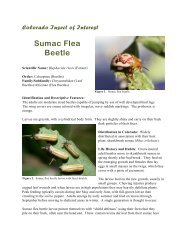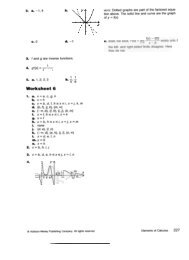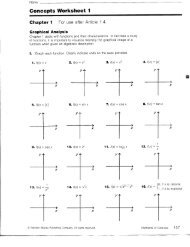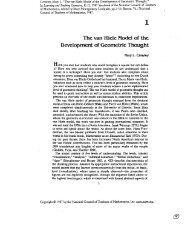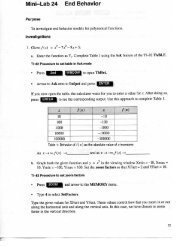Module 4 Using TI-89 or Voyage 200 to Explore the Concept of Limit
Module 4 Using TI-89 or Voyage 200 to Explore the Concept of Limit
Module 4 Using TI-89 or Voyage 200 to Explore the Concept of Limit
Create successful ePaper yourself
Turn your PDF publications into a flip-book with our unique Google optimized e-Paper software.
Finding<br />
Compare 2.87 < x < 3.13667 with <strong>the</strong> inequality 3 – < x < 3 + . It must follow that 3 – 2.87<br />
and 3 + 3.13667 . However, solving <strong>the</strong>se two equations f<strong>or</strong> yields two different values:<br />
0.13 and 0.13667. As in lesson 4.1, <strong>the</strong> smaller <strong>of</strong> <strong>the</strong> two values is <strong>the</strong> c<strong>or</strong>rect answer:<br />
0.13.<br />
Smaller Tolerance<br />
The second <strong>to</strong>lerance you found in lesson 4.1 came from answering <strong>the</strong> question<br />
How close should x be <strong>to</strong> 3 so that is within 0.01 <strong>of</strong> 2<br />
4.2.1 Rephrase this question with compound inequalities.<br />
4.2.2 Use <strong>the</strong> solve( command <strong>to</strong> solve <strong>the</strong> first compound inequality.<br />
4.2.3 Compare your answer <strong>to</strong> 4.2.2 with <strong>the</strong> inequality 3 – < x < 3 + and find a value <strong>of</strong> , <strong>the</strong><br />
x-<strong>to</strong>lerance.<br />
Finding a Generalized Solution<br />
Suppose that you are asked <strong>to</strong> find values <strong>of</strong> that c<strong>or</strong>respond <strong>to</strong> smaller and smaller <strong>to</strong>lerances<br />
f<strong>or</strong> y around y = 3. Ra<strong>the</strong>r than going through <strong>the</strong> same process over and over f<strong>or</strong> various y-<br />
<strong>to</strong>lerances, you could solve <strong>the</strong> problem once with a generalized y-<strong>to</strong>lerance. Call this general y-<br />
<strong>to</strong>lerance , <strong>the</strong> Greek letter "epsilon." The Greek letters delta, , and epsilon, , will be used <strong>to</strong><br />
represent small positive numbers.<br />
The <strong>to</strong>lerance question <strong>the</strong>n becomes<br />
How close should x be <strong>to</strong> 3 so that is within <strong>of</strong> 2<br />
Rephrasing <strong>the</strong> Question<br />
The question can be rephrased using inequalities as<br />
Find a positive number so that 2 – < < 2 + whenever 3 – < x < 3 +<br />
Solving <strong>the</strong> Left Inequality: 2 – <<br />
• Solve <strong>the</strong> left side <strong>of</strong> <strong>the</strong> inequality 2 – < < 2 + with <strong>the</strong> command<br />
solve(2-<br />
= (3x–5),x)<br />
The Greek letter can be entered in <strong>the</strong> <strong>TI</strong>-<strong>89</strong> by pressing .




